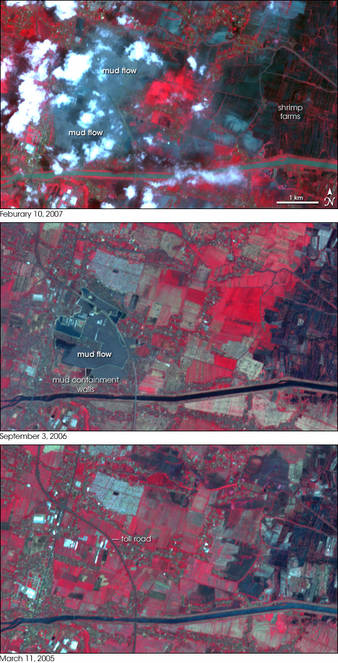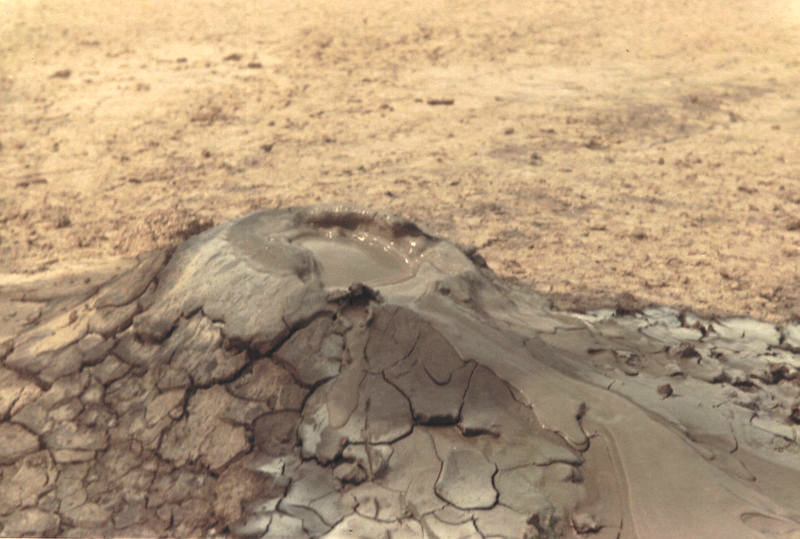Chris - Hello Richard. Thank you for joining us. How much mud are we talking about coming out of these mud volcanoes?
R ichard - It's been erupting 20-50,000 cubic metres per day for the last two years. It now covers seven square kilometres. It's about 20m thick in its central part and then sort of feathers out a bit like a pancake, basically.
ichard - It's been erupting 20-50,000 cubic metres per day for the last two years. It now covers seven square kilometres. It's about 20m thick in its central part and then sort of feathers out a bit like a pancake, basically.
Chris - When we say a 'mud volcano' is it genuinely mud that's coming out?
Richard - It's a mixture of mud, saline water and gases: methane, hydrogen sulphide, carbon dioxide. It's a mix. It's about 79% water and the actual mud is about 20%. It's a very dilute mud volcano.
Chris - What's the impact on the local environment of this?
Richard - Well, unfortunately this is the only mud volcano that's erupted into a highly populated area so 30,000 people have lost their homes. There's been 13 fatalities. There are factories that have had to close, schools etcetera. Because this thing is carrying on and developing all sorts of other things are starting to happen. The area is subsiding, the central parts of the volcano are subsiding at 4cm per day. It doesn't take long to work out that's about 14m per year. As long as the mud volcano continues the effects are going to increase and one can only speculate that in ten or so years' time and it's still erupting that rivers may have been diverted. All sorts of environmental impacts will have occurred.
Chris - Geologically speaking, what is going on underneath this mud volcano?
Richard - Down at about 3000m depth there is a limestone called the kujung limestone and this is a fantastic aquifer. It contains a lot of water. It has a lot of permeability which means the water can flow very easily. That is leaking up into a mudstone which is a 100ft higher up and then it's pulling with it the mudstone and bringing it to the surface. It's driven by pressure but also there's gas in the mud-water mix. That gas is also probably providing some of the lift mechanism in similar ways to the earlier speaker who talked about igneous volcanoes.
Chris - What do we think triggered this to happen?
Richard - Well it was almost certainly triggered by the drilling of an exploration well. We've now got detailed data from the well. The well was being drilled 150m away from where the eruption started. We know that on the 27th May overnight, going on to the early morning of the 28th May in 2006, they had some major operation problems. I'll summarise what actually happened. Basically, they had what is called a kick which is an influx of gas and water into the well bore. The only thing they could do to stop this kick of gas and water coming to the surface was to shut in valves at the surface. When they shut those valves in they recorded pressures that went beyond the critical pressure at which the underground rocks started to fracture. So the fractures basically developed and propagated to the surface. The following morning, May 29th 2006, mud water and gas started to erupt.
Chris - But the company have gone on record saying it was a local earthquake that did this?
Richard - It's not so local. It was 280km away, 6.3 in terms of magnitude. It's been shown by Michael Manger who's a Professor In Berkeley that this earthquake would have been too small and too far away. In the paper we've just published we've shown in the first part of the paper the earthquake was really just too small and too far away. The second part of the paper lays bare all the data and all the facts on what happened with the drilling of this exploration well.
Richard VN - This thing has been going for two years. When is it going to stop?
 Richard - Very good question. It's gone on for two years pretty much unabated which means they have tapped into a very, very good aquifer. We can estimate how long we continue for by looking at the size of the aquifer, the original pressure in the aquifer and how long it would take for that pressure to drop to normal levels. The fact it has gone on for two years without showing signs of stopping I think means it will go on for many years to come. Even when the pressure has depleted there will be gas in the system. The gas provides a lift mechanism as well: just like taking the lid off a Coca Cola(TM) bottle. The gas will pull the mud up. It will give it some buoyancy.
Richard - Very good question. It's gone on for two years pretty much unabated which means they have tapped into a very, very good aquifer. We can estimate how long we continue for by looking at the size of the aquifer, the original pressure in the aquifer and how long it would take for that pressure to drop to normal levels. The fact it has gone on for two years without showing signs of stopping I think means it will go on for many years to come. Even when the pressure has depleted there will be gas in the system. The gas provides a lift mechanism as well: just like taking the lid off a Coca Cola(TM) bottle. The gas will pull the mud up. It will give it some buoyancy.
- Previous Quakes from within the magma
- Next Finding Forgotten Fingerprints









Comments
Add a comment